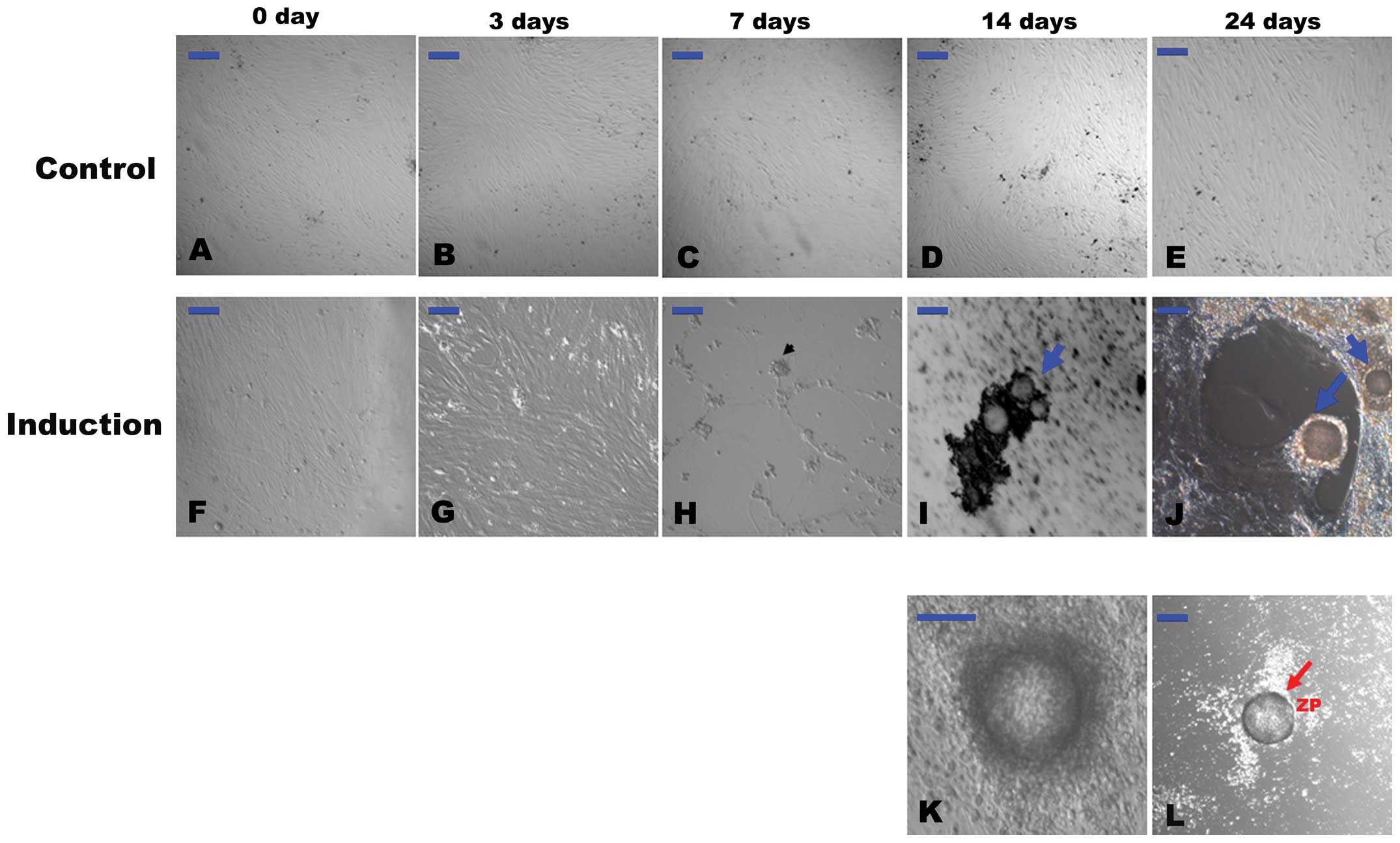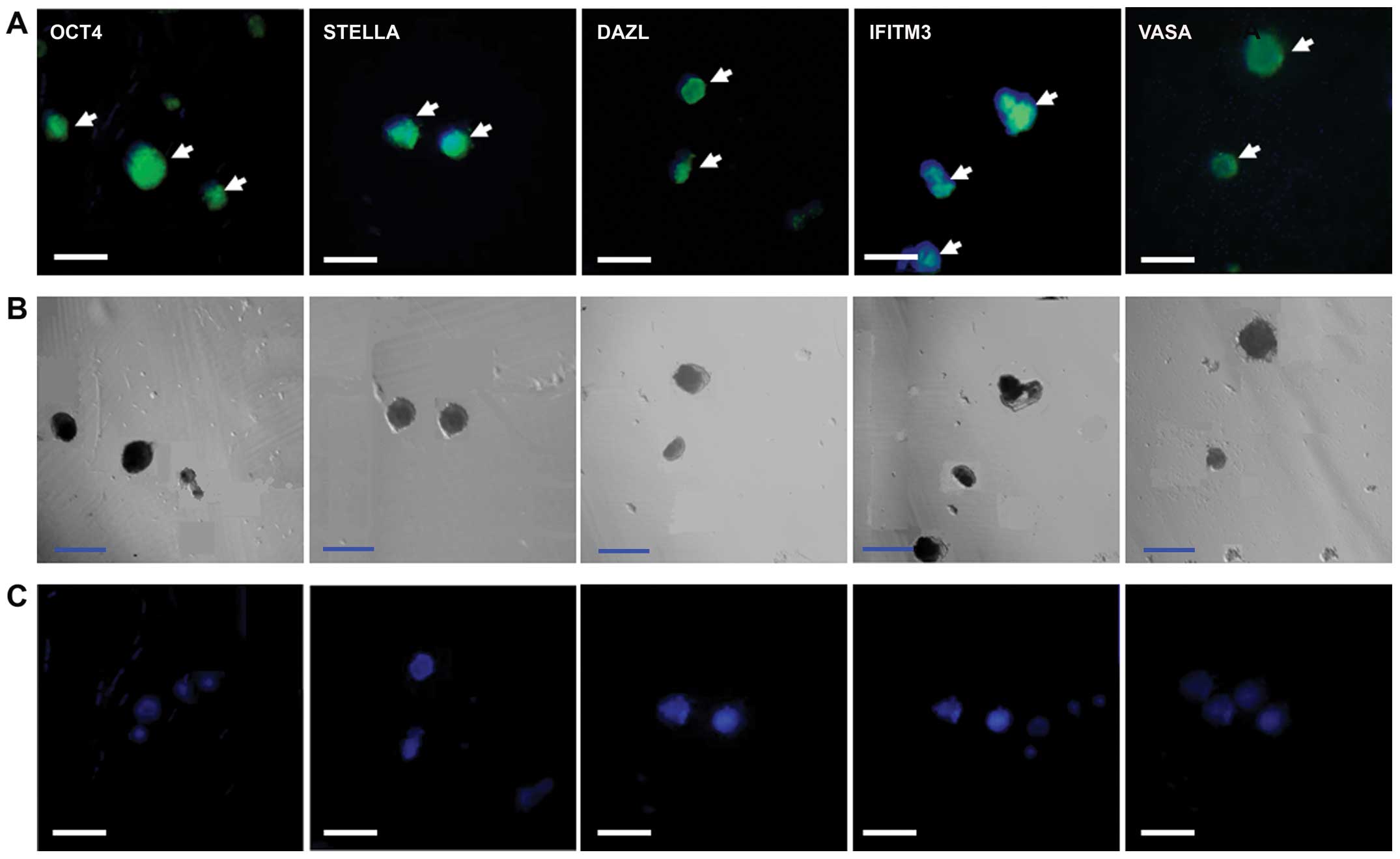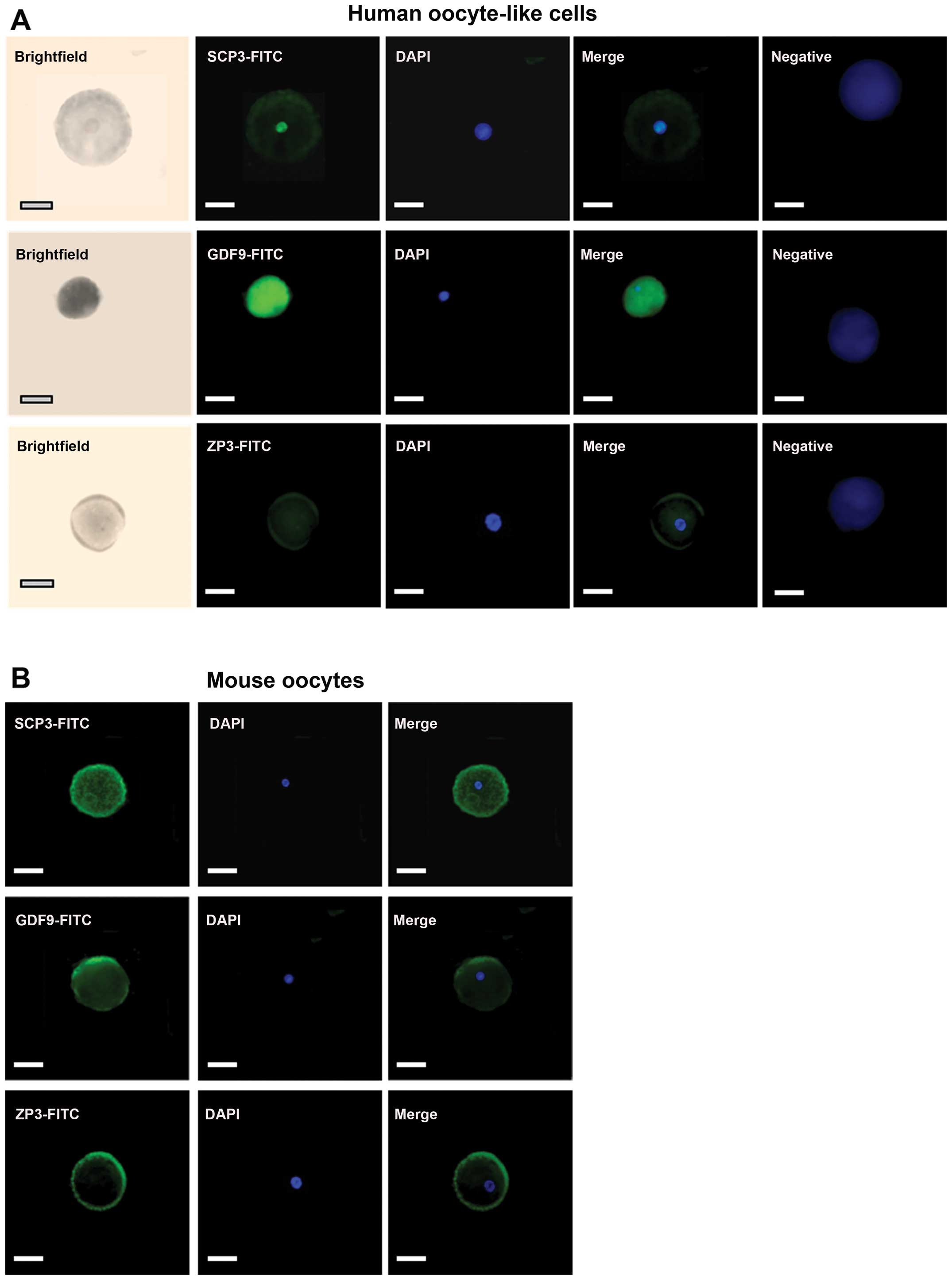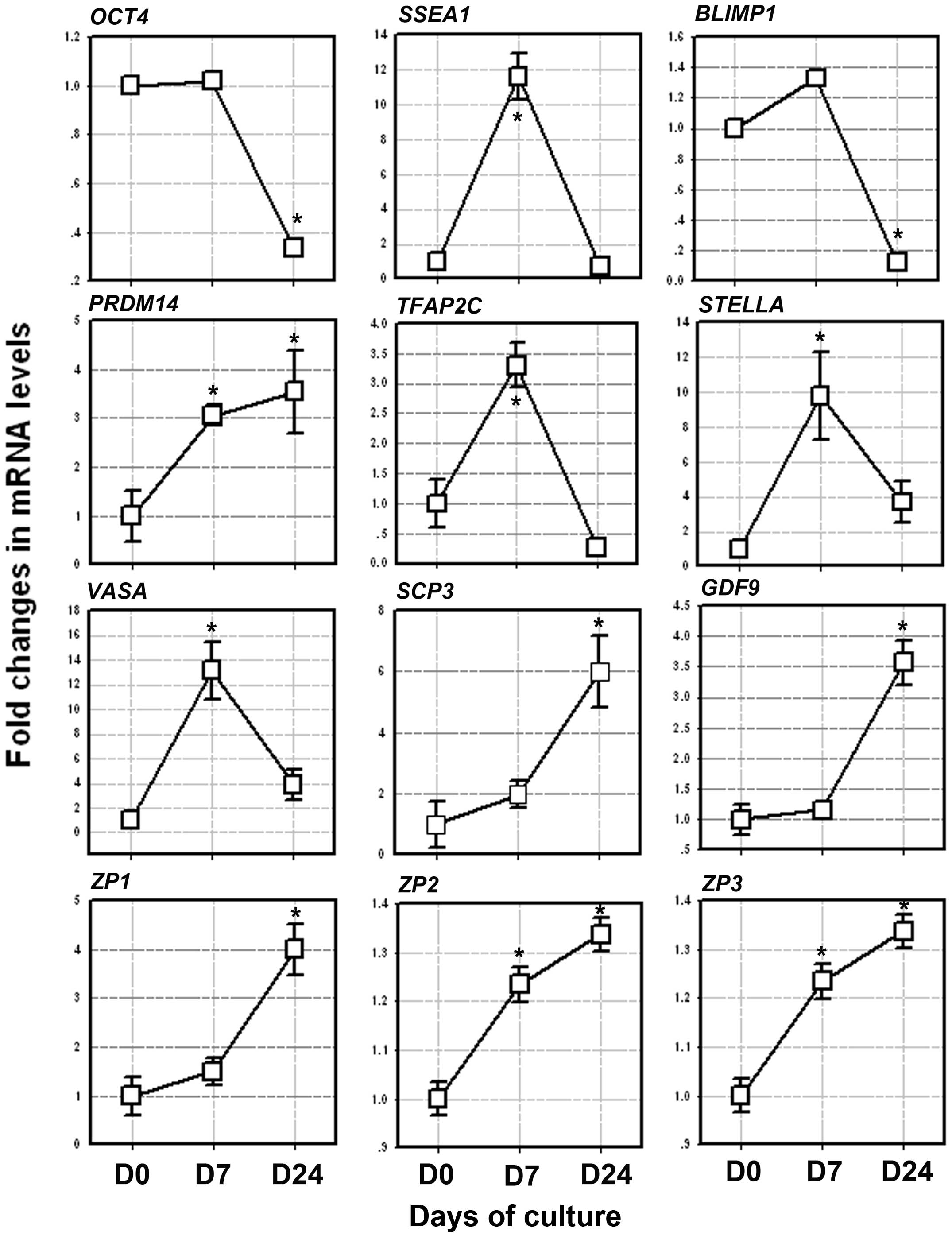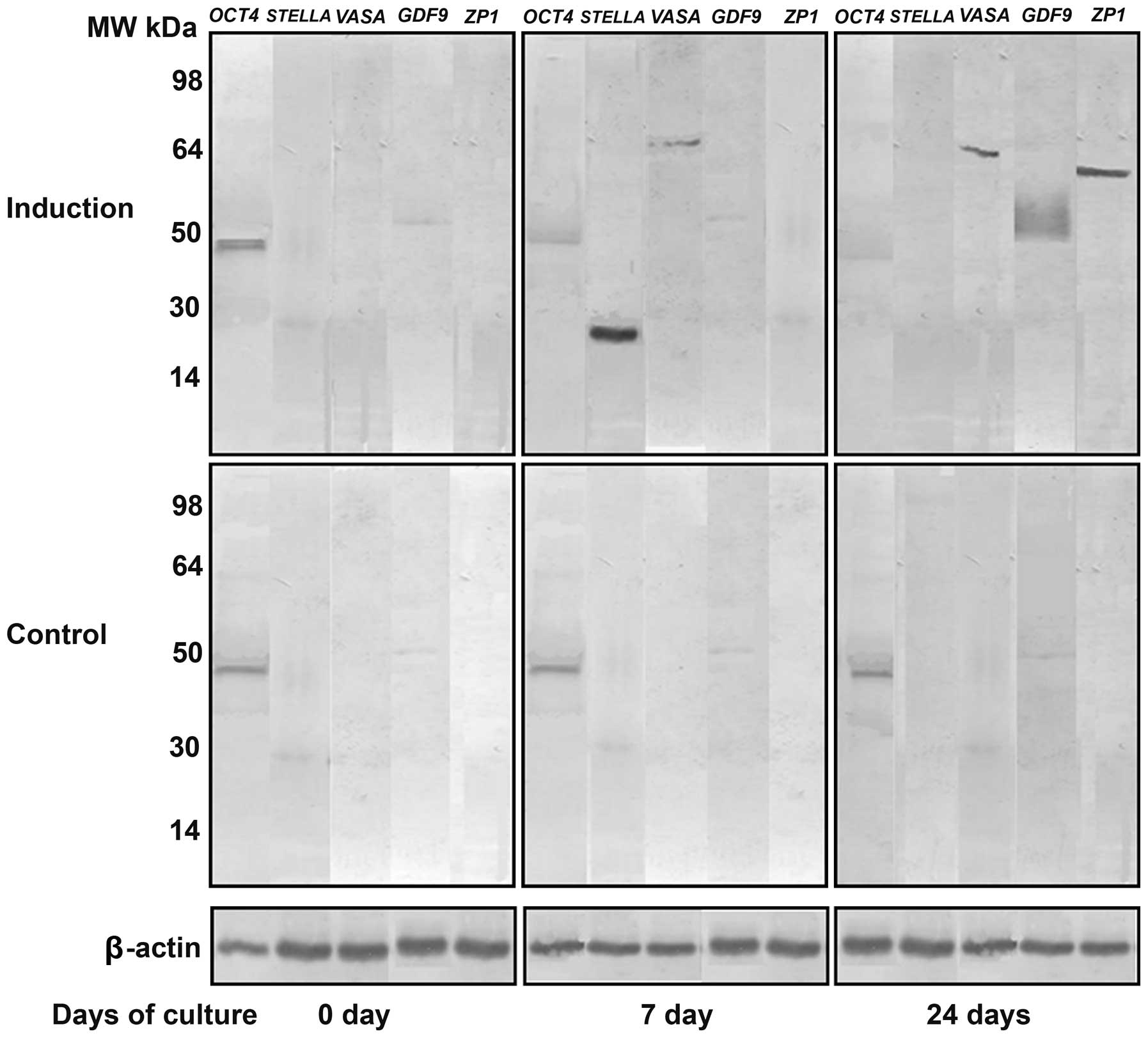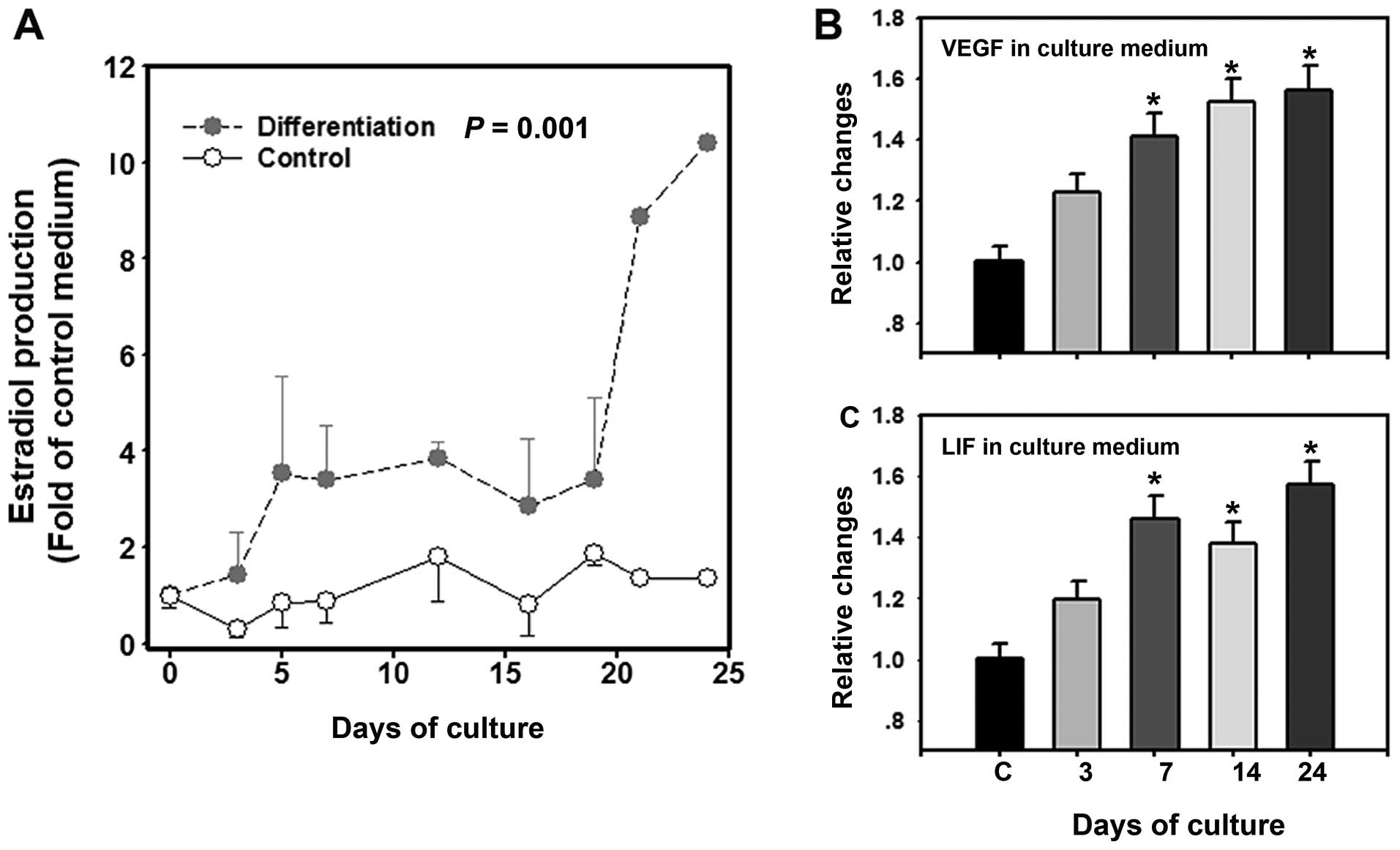|
1
|
Marques-Mari AI, Lacham-Kaplan O, Medrano
JV, Pellicer A and Simón C: Differentiation of germ cells and
gametes from stem cells. Hum Reprod Update. 15:379–390. 2009.
View Article : Google Scholar : PubMed/NCBI
|
|
2
|
Hübner K, Fuhrmann G, Christenson LK,
Kehler J, Reinbold R, De La, Fuente R, Wood J, Strauss JF III,
Boiani M and Schöler HR: Derivation of oocytes from mouse embryonic
stem cells. Science. 300:1251–1256. 2003. View Article : Google Scholar : PubMed/NCBI
|
|
3
|
Qing T, Shi Y, Qin H, Ye X, Wei W, Liu H,
Ding M and Deng H: Induction of oocyte-like cells from mouse
embryonic stem cells by co-culture with ovarian granulosa cells.
Differentiation. 75:902–911. 2007.PubMed/NCBI
|
|
4
|
Wei W, Qing T, Ye X, Liu H, Zhang D, Yang
W and Deng H: Primordial germ cell specification from embryonic
stem cells. PLoS One. 3:e40132008. View Article : Google Scholar : PubMed/NCBI
|
|
5
|
Clark AT, Bodnar MS, Fox M, Rodriquez RT,
Abeyta MJ, Firpo MT and Pera RA: Spontaneous differentiation of
germ cells from human embryonic stem cells in vitro. Hum Mol Genet.
13:727–739. 2004. View Article : Google Scholar : PubMed/NCBI
|
|
6
|
Kee K, Gonsalves JM, Clark AT and Pera RA:
Bone morphogenetic proteins induce germ cell differentiation from
human embryonic stem cells. Stem Cells Dev. 15:831–837. 2006.
View Article : Google Scholar
|
|
7
|
Chen HF, Kuo HC, Chien CL, Shun CT, Yao
YL, Ip PL, Chuang CY, Wang CC, Yang YS and Ho HN: Derivation,
characterization and differentiation of human embryonic stem cells:
Comparing serum-containing versus serum-free media and evidence of
germ cell differentiation. Hum Reprod. 22:567–577. 2007. View Article : Google Scholar
|
|
8
|
Dyce PW, Wen L and Li J: In vitro germline
potential of stem cells derived from fetal porcine skin. Nat Cell
Biol. 8:384–390. 2006. View
Article : Google Scholar : PubMed/NCBI
|
|
9
|
Dyce PW, Liu J, Tayade C, Kidder GM, Betts
DH and Li J: In vitro and in vivo germ line potential of stem cells
derived from newborn mouse skin. PLoS One. 6:e203392011. View Article : Google Scholar : PubMed/NCBI
|
|
10
|
Dyce PW, Shen W, Huynh E, Shao H,
Villagómez DA, Kidder GM, King WA and Li J: Analysis of oocyte-like
cells differentiated from porcine fetal skin-derived stem cells.
Stem Cells Dev. 20:809–819. 2011. View Article : Google Scholar
|
|
11
|
Johnson J, Bagley J, Skaznik-Wikiel M, et
al: Oocyte generation in adult mammalian ovaries by putative germ
cells in bone marrow and peripheral blood. Cell. 122:303–315. 2005.
View Article : Google Scholar : PubMed/NCBI
|
|
12
|
Bukovsky A, Svetlikova M and Caudle MR:
Oogenesis in cultures derived from adult human ovaries. Reprod Biol
Endocrinol. 3:172005. View Article : Google Scholar : PubMed/NCBI
|
|
13
|
Toyooka Y, Tsunekawa N, Akasu R and Noce
T: Embryonic stem cells can form germ cells in vitro. Proc Natl
Acad Sci USA. 100:11457–11462. 2003. View Article : Google Scholar : PubMed/NCBI
|
|
14
|
Librach CL, Yie SM and Xiao R: Method of
isolation and use of cells derived from first trimester umbilical
cord tissue. US Patent 20090074731 A1. Filed May 2, 2008; issued
March 19, 2009.
|
|
15
|
Hong SH, Maghen L, Kenigsberg S, et al:
Ontogeny of human umbilical cord perivascular cells: Molecular and
fate potential changes during gestation. Stem Cells Dev.
22:2425–2439. 2013. View Article : Google Scholar : PubMed/NCBI
|
|
16
|
Qiu P, Bai Y, Pan S, Li W, Liu W and Hua
J: Gender depended potentiality of differentiation of human
umbilical cord mesenchymal stem cells into oocyte-Like cells in
vitro. Cell Biochem Funct. 31:365–373. 2013. View Article : Google Scholar : PubMed/NCBI
|
|
17
|
Livak KJ and Schmittgen TD: Analysis of
relative gene expression data using real-time quantitative PCR and
the 2(-Delta Delta C(T)) Method. Methods. 25:402–408. 2001.
View Article : Google Scholar
|
|
18
|
Panula S, Medrano JV, Kee K, et al: Human
germ cell differentiation from fetal- and adult-derived induced
pluripotent stem cells. Hum Mol Genet. 20:752–762. 2011. View Article : Google Scholar :
|
|
19
|
Lacham-Kaplan O, Chy H and Trounson A:
Testicular cell conditioned medium supports differentiation of
embryonic stem cells into ovarian structures containing oocytes.
Stem Cells. 24:266–273. 2006. View Article : Google Scholar
|
|
20
|
Lange UC, Saitou M, Western PS, Barton SC
and Surani MA: The fragilis interferon-inducible gene family of
transmembrane proteins is associated with germ cell specification
in mice. BMC Dev Biol. 3:12003. View Article : Google Scholar : PubMed/NCBI
|
|
21
|
Wongtrakoongate P, Jones M, Gokhale PJ and
Andrews PW: STELLA facilitates differentiation of germ cell and
endodermal lineages of human embryonic stem cells. PLoS One.
8:e568932013. View Article : Google Scholar : PubMed/NCBI
|
|
22
|
Ruggiu M, Speed R, Taggart M, McKay SJ,
Kilanowski F, Saunders P, Dorin J and Cooke HJ: The mouse Dazla
gene encodes a cytoplasmic protein essential for gametogenesis.
Nature. 389:73–77. 1997. View
Article : Google Scholar : PubMed/NCBI
|
|
23
|
Kee K, Angeles VT, Flores M, Nguyen HN and
Reijo Pera RA: Human DAZL, DAZ and BOULE genes modulate primordial
germ-cell and haploid gamete formation. Nature. 462:222–225. 2009.
View Article : Google Scholar : PubMed/NCBI
|
|
24
|
Toyooka Y, Tsunekawa N, Takahashi Y,
Matsui Y, Satoh M and Noce T: Expression and intracellular
localization of mouse Vasa-homologue protein during germ cell
development. Mech Dev. 93:139–149. 2000. View Article : Google Scholar : PubMed/NCBI
|
|
25
|
Castrillon DH, Quade BJ, Wang TY, Quigley
C and Crum CP: The human VASA gene is specifically expressed in the
germ cell lineage. Proc Natl Acad Sci USA. 97:9585–9590. 2000.
View Article : Google Scholar : PubMed/NCBI
|
|
26
|
Kehler J, Tolkunova E, Koschorz B, et al:
Oct4 is required for primordial germ cell survival. EMBO Rep.
5:1078–1083. 2004. View Article : Google Scholar : PubMed/NCBI
|
|
27
|
Magnúsdóttir E, Dietmann S, Murakami K,
Günesdogan U, Tang F, Bao S, Diamanti E, Lao K, Gottgens B and Azim
Surani M: A tripartite transcription factor network regulates
primordial germ cell specification in mice. Nat Cell Biol.
15:905–915. 2013. View
Article : Google Scholar : PubMed/NCBI
|
|
28
|
Chu LF, Surani MA, Jaenisch R and Zwaka
TP: Blimp1 expression predicts embryonic stem cell development in
vitro. Curr Biol. 21:1759–1765. 2011. View Article : Google Scholar : PubMed/NCBI
|
|
29
|
Kerr CL, Hill CM, Blumenthal PD and
Gearhart JD: Expression of pluripotent stem cell markers in the
human fetal testis. Stem Cells. 26:412–421. 2008. View Article : Google Scholar
|
|
30
|
Yuan L, Liu JG, Hoja MR, Wilbertz J,
Nordqvist K and Höög C: Female germ cell aneuploidy and embryo
death in mice lacking the meiosis-specific protein SCP3. Science.
296:1115–1118. 2002. View Article : Google Scholar : PubMed/NCBI
|
|
31
|
Aaltonen J, Laitinen MP, Vuojolainen K, et
al: Human growth differentiation factor 9 (GDF-9) and its novel
homolog GDF-9B are expressed in oocytes during early
folliculogenesis. J Clin Endocrinol Metab. 84:2744–2750.
1999.PubMed/NCBI
|
|
32
|
Lefièvre L, Conner SJ, Salpekar A, et al:
Four zona pellucida glycoproteins are expressed in the human. Hum
Reprod. 19:1580–1586. 2004. View Article : Google Scholar : PubMed/NCBI
|
|
33
|
Abir R, Fisch B, Jin S, Barnnet M,
Freimann S, Van den Hurk R, Feldberg D, Nitke S, Krissi H and Ao A:
Immunocytochemical detection and RT-PCR expression of leukaemia
inhibitory factor and its receptor in human fetal and adult
ovaries. Mol Hum Reprod. 10:313–319. 2004. View Article : Google Scholar : PubMed/NCBI
|
|
34
|
Lee A, Christenson LK, Patton PE, Burry KA
and Stouffer RL: Vascular endothelial growth factor production by
human luteinized granulosa cells in vitro. Hum Reprod.
12:2756–2761. 1997. View Article : Google Scholar
|
|
35
|
De Matos DG, Miller K, Scott R, Tran CA,
Kagan D, Nataraja SG, Clark A and Palmer S: Leukemia inhibitory
factor induces cumulus expansion in immature human and mouse
oocytes and improves mouse two-cell rate and delivery rates when it
is present during mouse in vitro oocyte maturation. Fertil Steril.
90:2367–2375. 2008. View Article : Google Scholar : PubMed/NCBI
|
|
36
|
Biswas D and Hyun SH: Supplementation with
vascular endothelial growth factor during in vitro maturation of
porcine cumulus oocyte complexes and subsequent developmental
competence after in vitro fertilization. Theriogenology.
76:153–160. 2011. View Article : Google Scholar : PubMed/NCBI
|
|
37
|
Mareschi K, Ferrero I, Rustichelli D,
Aschero S, Gammaitoni L, Aglietta M, Madon E and Fagioli F:
Expansion of mesenchymal stem cells isolated from pediatric and
adult donor bone marrow. J Cell Biochem. 97:744–754. 2006.
View Article : Google Scholar
|
|
38
|
Choumerianou DM, Martimianaki G, Stiakaki
E, Kalmanti L, Kalmanti M and Dimitriou H: Comparative study of
stemness characteristics of mesenchymal cells from bone marrow of
children and adults. Cytotherapy. 12:881–887. 2010. View Article : Google Scholar : PubMed/NCBI
|
|
39
|
Yu X, Wang N, Qiang R, Wan Q, Qin M, Chen
S and Wang H: Human amniotic fluid stem cells possess the potential
to differentiate into primordial follicle oocytes in vitro. Biol
Reprod. 90:732014. View Article : Google Scholar : PubMed/NCBI
|
|
40
|
Fortune JE: Ovarian follicular growth and
development in mammals. Biol Reprod. 50:225–232. 1994. View Article : Google Scholar : PubMed/NCBI
|
|
41
|
Gilchrist RB, Ritter LJ and Armstrong DT:
Oocyte-somatic cell interactions during follicle development in
mammals. Anim Reprod Sci. 82–83:431–446. 2004. View Article : Google Scholar
|















